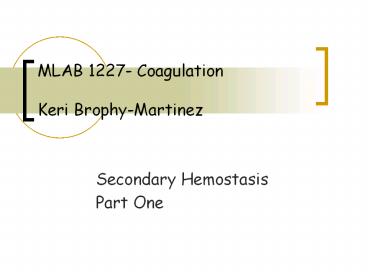Secondary Hemostasis PowerPoint PPT Presentation
1 / 18
Title: Secondary Hemostasis
1
MLAB 1227- CoagulationKeri Brophy-Martinez
- Secondary Hemostasis
- Part One
2
Coagulation system is kept in balance by
activators and inhibitors of clotting and
fibrinolysis. Clotting occurs when blood vessels
are damaged and activators of coagulation factors
are released. Clotting is controlled by
fibrinolysis. Inhibitors serve to bring the
system back into balance.
3
Review
- Primary hemostasis
- Unstable platelet plug formed
- Secondary hemostasis
- Reinforced platelet plug with fibrin clot
- Enzyme-mediated, cascade-like reactions
- End result insoluble fibrin clot
4
Theory of Blood Coagulation
- Classic theory (early 1900's) states that blood
remains fluid in the absence of thromboplastin - In the presence of thromboplastin and calcium, a
factor in the blood, prothrombin, is converted to
thrombin - Thrombin then acts upon another blood factor,
fibrinogen, and converts it to fibrin, which is
the final product of coagulation - Cascade/Domino /Waterfall Theory
- Coagulation factors are converted to active forms
by the preceding factor in a series of
biochemical reactions.
5
In a nutshell..
- Prothrombin thromboplastin thrombin
- Ca
- Fibrinogen thrombin
fibrin
6
Terms
- Zymogen
- Also called procoagulant or proenzyme
- Inactive circulating coagulation factor precursor
- Functions
- Serves as the first substrate for the preceding
enzyme in the cascade - Once activated, becomes an enzyme for the
following zymogen
7
Coagulation Mechanism (In vitro)Intrinsic,
Extrinsic, Common
- Initiation consists of 2 pathways
- Intrinsic
- Requires enzymes and protein co-factors present
in the plasma - Extrinsic
- Requires enzymes and protein co-factors present
in the plasma plus an activator (tissue factor
TF) - TF is not found in blood under normal conditions
- Common the third pathway
- Location of generation of fibrin clot
8
Coagulation Cascade
9
Breakdown of Factor Location
Intrinsic Pathway Extrinsic Pathway Common Pathway
Prekallikrein PK VII X
HK Tissue factor TF, III V
XII II
XI I
IX
VIII
10
Classification of Coagulation Factors
- Based on functional or structural properties
- Physical groupings
- Prothrombin
- Fibrinogen
- Contact
- Functional Groupings
- Substrate
- Cofactors
- Enzyme
11
Physical Groupings
12
Prothrombin Group
- II, VII, IX, X
- Protein C, Protein S, Protein Z
- Vitamin K dependent
- Synthesized in liver
- Small mw (50,000-100,000)
- Contain a domain that is critical for calcium
binding - Heat stable
- Inhibited by warfarin
13
Fibrinogen group
- I, V, VIII, XIII
- Thrombin acts on all these factors
- Synthesized in liver
- Exception VIIIvWF which is produced by
endothelial cells and megakaryocytes - Large mw (250,000)
- ALL are consumed in the clotting process, since
they are NOT enzymes
14
Contact Group
- XI, XII, HMWK(HK), PK
- Produced in liver
- Activated upon contact with a negatively charged
surface - Collagen in vivo
- Glass, Kaolin in vitro
- Large mw (80,000-173,000)
- Not consumed in coagulation, found in serum
- Purpose activate the intrinsic pathway
fibrinolytic system
15
Functional Groupings
- Substrates substance upon which enzymes act
- Factor Ifibrinogen
- Cofactors speed up the activities of enzymes
- (i.e) Factor V Proaccelerin
- Enzymes
- Transglutaminase
- Factor XIIIa only
- Serine protease
- Inactive until converted to enzymes
- Once activated, assist in reaction, but are not
consumed or used up
16
Whats so Special About Vitamin K?
- Where does it come from?
- Green leafy vegetables, fish and liver
- Gram-negative intestinal bacteria
- What does it do?
- Vitamin K is necessary for the carboxylation of
glutamic acid. Carboxylation is essential for
binding coagulation factors to negatively-charged
phospholipid surfaces via Ca bridges.
Carboxylation reactions also reduce vitamin K to
be recycled.
17
Whats so Special About Vitamin K?
- Why do we care?
- Vitamin K antagonist drugs such as
warfin/coumadin inhibit the activity of the
recycling of Vitamin K, so the reduced form can
not be made - Deficiencies of Vitamin K result in the
production of non-functional factors which can
not participate in coagulation reactions
18
References
- McKenzie, Shirlyn B., and J. Lynne. Williams.
"Chapter 30." Clinical Laboratory Hematology.
Boston Pearson, 2010. Print.

